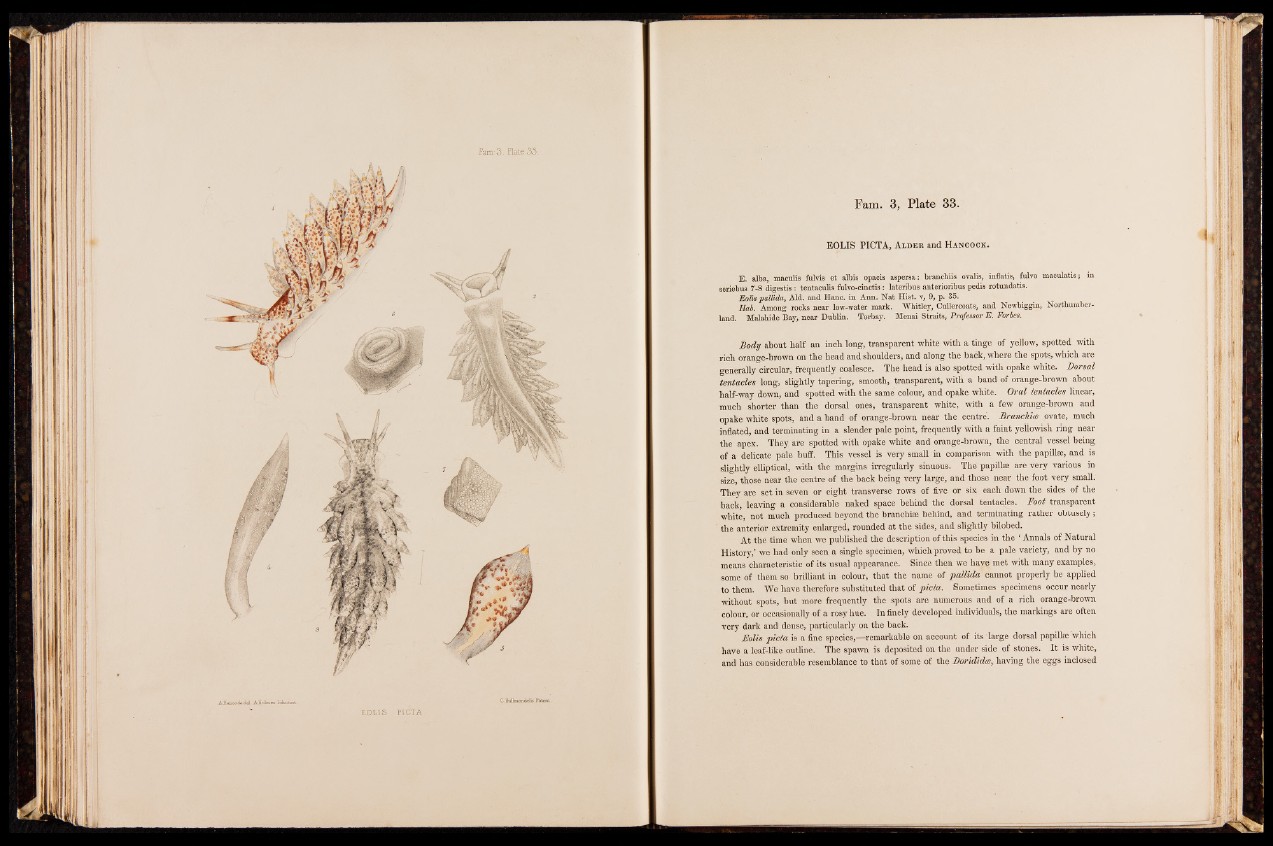
fam: 3 - flat® 33.
EOLIS PICT A
Fam. 3, Plate 33.
EOLIS PICTA, Alder and Hancock.
E. alba, ™n»nlis Mvis et albis opacis aspersa: brancbiis ovalis, inflatis, fulvo maculatis; in
seriebus 7-8 digestis : tentaculis fulvo-cinctia: lateribus anterioribns pedis rotundatis.
Eolis pallida, Aid. and Hanc. in Ann. Nat Hist, v, 9, p. 85.
Hab. Among rocks near low-water mark. "Whitley, Cullercoats, and Newbiggin, Northumberland.
Malahide Bay, near Dublin. Torbay. Menai Straits, Professor E. Forbes.
Body about half an inch long, transparent white with a tinge of yellow, spotted with
rich orange-brown on the head and shoulders, and along the back, where the spots, which are
generally circular, frequently coalesce. The head is also spotted with opake white. Dorsal
tentacles long, slightly tapering, smooth, transparent, with a band of orange-brown about
half-way down, and spotted with the same colour, and opake white. Oral tentacles linear,
much shorter than the dorsal ones, transparent white, with a few orange-brown and
opake white spots, and a band of orange-brown near the centre. Branchia ovate, much
inflated, and terminating in a slender pale point, frequently with a faint yellowish ring near
the apex. They, are spotted with opake white and orange-brown, the central vessel being
of a delicate pale buff. This vessel is very small in comparison with the papillae, and is
slightly elliptical, with the margins irregularly sinuous. The papillae are very various in
size, those near the centre of the back being very large, and those near the foot very small.
They are set in seven or eight transverse rows of five or six each down the sides of the
back, leaving a considerable naked space behind the dorsal tentacles. Foot transparent
white, not much produced beyond the branchiae behind, and terminating rather obtusely;
" the anterior extremity enlarged, rounded at the sides, and slightly bilobed.
At the time when we published the description of this species in the ‘ Annals of Natural
History,’ we had only seen a single specimen, which proved to be a pale variety, and by no
means characteristic of its usual appearance. Since then we have met with many examples,
some of them so brilliant in colour, that the name of pallida cannot properly be applied
to them. We have therefore substituted that of picta. Sometimes specimens occur nearly
without spots, but more frequently the spots are numerous and of a rich orange-brown
colour, or occasionally of a rosy hue. In finely developed individuals, the markings are often
very dark and dense, particularly pn the back.
Eolis pic ta is a fine species,—remarkable on account of its large dorsal papillae which
have a leaf-like outline. The spawn is deposited on the under side of stones. It is white,
and has considerable resemblance to that of some of the Doridida, having the eggs inclosed